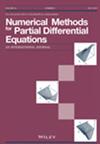麦克斯韦方程组的符合时空方法的数值研究
IF 1.7
3区 数学
Q1 MATHEMATICS, APPLIED
引用次数: 0
摘要
随时间变化的麦克斯韦方程组支配着电磁学。在一定条件下,我们可以把这些方程改写成二阶偏微分方程,在这种情况下就是矢量波动方程。对于矢量波动方程,我们研究了数值格式及其挑战。为此,我们考虑一个时空变分的设置,也就是说,时间只是另一个空间维度。更具体地说,我们将分部积分法应用于时间和空间,从而得到具有不同试验和测试空间的时空变分公式。本文研究了张量积型的一致性离散化,得到了需要CFL条件的Galerkin-Petrov有限元方法。为了克服CFL条件,我们使用希尔伯特型变换,该变换导致具有相等试验和测试空间的变分公式。一致的时空离散化得到了一种新的无条件稳定的Galerkin-Bubnov有限元方法。通过数值算例验证了Galerkin-Bubnov有限元方法的有效性。此外,我们研究了右侧的不同投影及其对收敛速率的影响。本文是朝着更稳定的计算和更好地理解符合时空方法的矢量波方程迈出的第一步。本文章由计算机程序翻译,如有差异,请以英文原文为准。
Numerical study of conforming space‐time methods for Maxwell's equations
Abstract Time‐dependent Maxwell's equations govern electromagnetics. Under certain conditions, we can rewrite these equations into a partial differential equation of second order, which in this case is the vectorial wave equation. For the vectorial wave equation, we examine numerical schemes and their challenges. For this purpose, we consider a space‐time variational setting, that is, time is just another spatial dimension. More specifically, we apply integration by parts in time as well as in space, leading to a space‐time variational formulation with different trial and test spaces. Conforming discretizations of tensor‐product type result in a Galerkin–Petrov finite element method that requires a CFL condition for stability which we study. To overcome the CFL condition, we use a Hilbert‐type transformation that leads to a variational formulation with equal trial and test spaces. Conforming space‐time discretizations result in a new Galerkin–Bubnov finite element method that is unconditionally stable. In numerical examples, we demonstrate the effectiveness of this Galerkin–Bubnov finite element method. Furthermore, we investigate different projections of the right‐hand side and their influence on the convergence rates. This paper is the first step toward a more stable computation and a better understanding of vectorial wave equations in a conforming space‐time approach.
求助全文
通过发布文献求助,成功后即可免费获取论文全文。
去求助
来源期刊
CiteScore
7.20
自引率
2.60%
发文量
81
审稿时长
9 months
期刊介绍:
An international journal that aims to cover research into the development and analysis of new methods for the numerical solution of partial differential equations, it is intended that it be readily readable by and directed to a broad spectrum of researchers into numerical methods for partial differential equations throughout science and engineering. The numerical methods and techniques themselves are emphasized rather than the specific applications. The Journal seeks to be interdisciplinary, while retaining the common thread of applied numerical analysis.

 求助内容:
求助内容: 应助结果提醒方式:
应助结果提醒方式:


